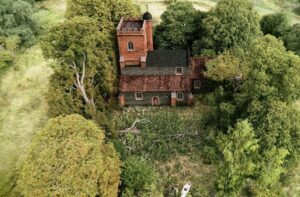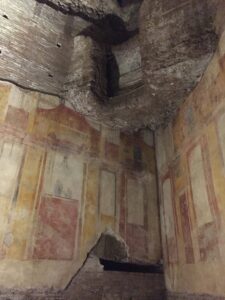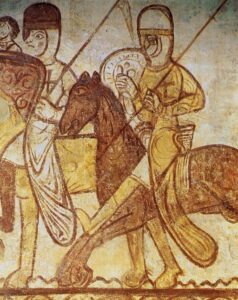This entry in our ongoing Provenance Series addresses the phenomenon of unexpected archaeological discoveries and their role in spurring historical and cultural research.

Portrait of Richard III in the National Portrait Gallery
Archeologists often spend years digging for and uncovering cultural heritage artifacts around the world. These artifacts serve as windows into the past and are pivotal in piecing together the history of the world and its myriad cultures. Some famous discoveries, however, were found entirely by accident rather than by careful planning. For example, in 1974, a group of Chinese farmers digging a well struck the head of a clay figure with their shovels. The resulting excavation revealed an ancient tomb with thousands of life-size sculptures depicting horses and warriors in full armor and battle formation, guarding the remains of an emperor. We now know of the sculptures as the Terra Cotta Warriors. In 1947, a Bedouin goat and sheep herder searching for his lost goat happened upon a cave that contained papyrus scrolls later confirmed to be the Dead Sea Scrolls. These contain some of the earliest known writings from the Bible and new fragments are still being discovered today.
While some discoveries were unexpected because they were found by accident, other discoveries are shocking due to the location where they were found. The body of Richard III, a king from the Plantagenet line who ruled England during the medieval Wars of the Roses (and later inspired one of Shakespeare’s plays), was famously uncovered in a parking lot in Leicester in 2012, after a group of archeologists from the local university and members of the Richard III Society coordinated efforts to find his body. Previously, it was believed that Richard III had been buried in Greyfriars Church in Leicester, which was likely destroyed during the reign of Henry VIII.
Over the past few years, there have been several notable unexpected discoveries, including the following:
4,000-year-old Log Coffin in a Pond at an English Golf Course
A 4,000-year-old log coffin containing human remains and a “perfectly preserved ax” was discovered in a small pond at the Tetney Golf Club near Grimsby, England. The club owner’s feared that the discovery would hurt business, and the excavation team sought to obtain sufficient information about the artifacts. Hence, although the discovery was made in the summer of 2018, it was not announced until this past September.
Three years ago, workers on the golf course were using a large excavator to carry out improvements to the pond. Unexpectedly, it collided with a very large, hard object. The owners of the course notified local authorities and luckily Hugh Willmott, an archeologist and senior lecturer at the University of Sheffield, and his archeological team were working at a nearby excavation site. They were able to arrive at the golf course the next day to carry out rescue measures.
Over the past three years archeologists, historians, and conservationists have been completing preservation works on these fragile artifacts. The coffin is around three meters long and one meter wide and is believed to be from the Bronze Age (since log coffins are only known to have been used then). The man in the coffin was estimated to be tall for that time (5 foot 9 inches), approximately in his 30s or 40s at the time of death, and likely someone of great stature in his community. The axe is considered rare, as only 12 of this type have been discovered in Britain. It has a wooden handle and a stone head, and is believed a “symbol of authority” rather than a tool used in practice.
Given the size of the coffin, the conservation process is still under way. Once complete, the coffin and axe will be displayed at the Collection Museum, an art and archeological museum in Lincolnshire. The discovery has been called a “brilliant learning experience” and is expected to produce valuable information on ancient regional burial practices.
Roman Artifacts Discovered Under an Abandoned Medieval Church near London

A CGI image showing what St. Mary’s Church may have looked like when built. Image: courtesy of HS2
Less than 150 miles from the golf course, another major find was discovered. Earlier this month, a team unearthed three Roman statues and a rare glass jug as they concluded their dig at St. Mary’s Church in Stoke Mandeville, a town 46 miles outside of London.
The “once in a lifetime” and “uniquely remarkable” find included two full stone torsos and heads of an adult man and woman, and a stone head of what appears to be a child. The lead archeologist noted the exceptional preservation of the sculptures, commenting: “[Y]ou really get an impression of the people they depict—literally looking into the faces of the past is a unique experience.” In addition, the team also uncovered pieces of a very rare and surprisingly intact hexagonal glass jug, for which there is only one other comparable item; the other job was discovered in Tunisia and is now on display at New York’s Metropolitan Museum of Art.
The artifacts were discovered at the site of an ancient Norman church. Researchers believe this site might originally have been a Bronze Age burial site. It was then the site of a Roman mausoleum built during the Roman occupation of Britain. Finally, it served as the site of St. Mary’s church, which was erected around 1080 C.E, renovated in the 13th 14th, and 17th centuries, and eventually torn down in the mid-20th century. This site’s rich history has been at the center of other archeological discoveries, including 3,000 bodies at the burial site of the church, Roman cremation urns, and painted walls and roof tiles.
This dig, funded by the U.K.’s national Department of Transport, is one of 60 sites that will be excavated ahead of the construction of the new H2S high-speed railway. This new, controversial railway will connect the expanse of the United Kingdom, but some surveys suggest that there are nearly 1,000 potential excavation sites along the proposed 350-mile route. It remains to be seen whether other archaeological discoveries will come to light.
Subway Station Development in Rome Leads to Additional Discoveries
In Rome, archeologists have been excavating at Amba Aradam in preparation for a new subway station that will connect Rome’s city center to towns in the eastern perimeter of the metropolitan area. Because the subway line is being built over 100 feet below ground, this has allowed archeologists to excavate much deeper than usual and, as a result, make a number of significant discoveries.

A Roman domus (not the one found under the subway station)
In 2016, the dig uncovered a military barrack from the 2nd C.E., during the rule of Emperor Hadrian. The find was so impressive that the government plans to create the city’s first “archaeological station.” Two years later, the team found a domus, or house, with a central courtyard, frescoed walls, patterned mosaic floors, a fountain, at least 14 rooms, rare wooden artifacts, and a similar sized structure 40 feet below ground, that is believed to have been used as a warehouse. This house likely belonged to the commander of the previously discovered military post. Given that the five-foot walls of the house were filled with dirt, researchers believe that it may have been buried intentionally in the third century, just prior to the construction of the walls of Rome in 271 C.E. As works on the subway line are ongoing, the likelihood of future discoveries remains a tantalizing possibility.
While some discoveries take place in the ground, some occur underwater.
Hoard of Roman Coins Found Along the Spanish Coast
In August 2021, two men on a family vacation were snorkeling when they came upon a stash of Roman coins – one of the largest of its kind ever discovered in Europe. The coins, dating back to the 4th-5th centuries C.E., had fallen into a rock crevice 20 feet underwater in Portitxol Bay by Xàbia, a popular tourist resort. The men removed eight coins with a Swiss Army knife and contacted the local authorities once they had inspected their find after surfacing. Authorities returned to the dive site with a team of underwater archaeologists from the University of Alicante and the Spanish Civil Guard. The team ultimately retrieved 53 coins, 3 nails and lead fragments (likely once part of the chest containing the hoard). The coins are in excellent condition, allowing researchers to read their inscriptions and identify the Roman rulers they depict. Rather than being lost in a shipwreck, the coins were probably hidden intentionally by a wealthy landowner to protect them from barbarian invaders during the decline of the Western Roman Empire. The individual most likely sank a boat in the bay with the intention of returning to claim his property but died before doing so. The coins will be restored and exhibited at the Soler Blasco Archaeological and Ethnographic Museum in Xàbia, while the regional government of Valencia is sponsoring further underwater excavations in the area.
Crusader Sword Discovered Off the Coast of Israel

12th Century painting of a Crusader
In October 2021, an amateur diver found a 900-year-old sword dating back to the Crusades off the northern coast of Israel. The sword, as well as other ancient artifacts, became visible after sands shifted on the sea floor. It was covered in seashells, barnacles, and other forms of sea life but is otherwise preserved in perfect condition. The “beautiful and rare find” belonged to a knight, although further restoration is required to identify whether it is of Christian or Muslim origin, as they typically used swords of a similar size and shape. Since the sword was buried in a deep layer of sand and not exposed to oxygen, it avoided rust and other degradation. Archaeologists expect further artifacts to surface, particularly since the site was once a hotbed of mercantile activity. In the meantime, the sword has been taken to a scientific laboratory under the auspices of the Israel Antiquities Authority for cleaning and further research.
We hope you have enjoyed reading about these surprising archaeological discoveries. Amineddoleh & Associates continues to remain invested in the preservation of historical and cultural artifacts. You can access the other entries in our Provenance Series here and read about our firm’s services here.